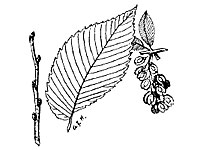Search the dictionary Advanced Search
How to use the Ojibwe People's Dictionary
American elm leaf and flower
Copyright
Minnesota DNR
- Description:
- "Leaf: Simple, alternate on stem, length 4" to 6"; rather thick, somewhat one-sided, dark green, doubly toothed on margin, generally rough above, smooth below; veins very pronounced, running in parallel lines from mid-rib to edge of leaf; turns yellow in autumn." -Minnesota DNR
"Before maturity of fruit and seed, of course, American elm must flower. It does so in very early spring, two to three weeks before leaf-out in mid-March. The flowers don’t call attention to themselves unless you know to look out for them. You’ll notice each branch has a maroonish hazy accent, the result of tens of thousands of tiny wind-pollinted flowers. In spite of having stamens and pistils in close proximity on such tiny flowers, American elm is almost completely self-sterile when field tested. After early spring flowering, fruit maturity occurs very rapidly. The samaras appear on the tree in April and are blowing in the wind and on the ground merely weeks later. American elms begin to produce a good seed crop before 20 years of age, and continue great reproductive output throughout the life of the tree. American elm was potentially a long-lived species. Many 100-200 year old elms are known and a few over 300 years have been recorded." Rob Paratley (University of Kentucky - College of Agriculture, Food and Environment), 'Economic Botany & Cultural History : American Elm'
For more information see https://www.dnr.state.mn.us/trees/american-elm.html & https://ufi.ca.uky.edu/treetalk/ecobot-american-elm
